The design in the following pic has been printed using Chikan-kari (wooden) blocks but has been embroidered by machine
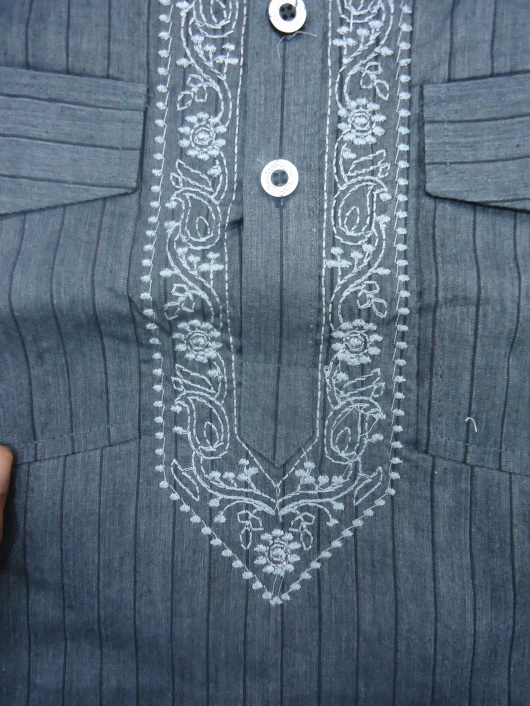
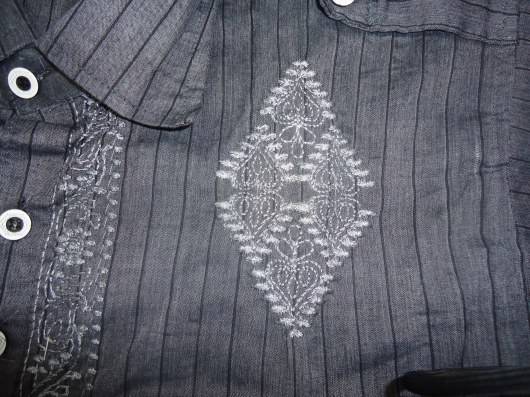
Kindly don’t get cheated.
Keep appreciating original & handmade Chikan-kari.
The design in the following pic has been printed using Chikan-kari (wooden) blocks but has been embroidered by machine


Kindly don’t get cheated.
Keep appreciating original & handmade Chikan-kari.
Many customers of mine comment that you are the most expensive in your industry. Some said it as a routine, but some were really serious. I took it and started putting some stuff that i did not believe in. My sales dipped.
When you come from the higher level of the pyramid to a slightly lower altitude you see that the area has broadened. You start getting a better footfall at your business place but your sales are least affected. I mean to say that if you lower your quality and you start imagining that it will pull up your sales, its not true.
So coming back to my point, the depression depressed me further until I saw this picture: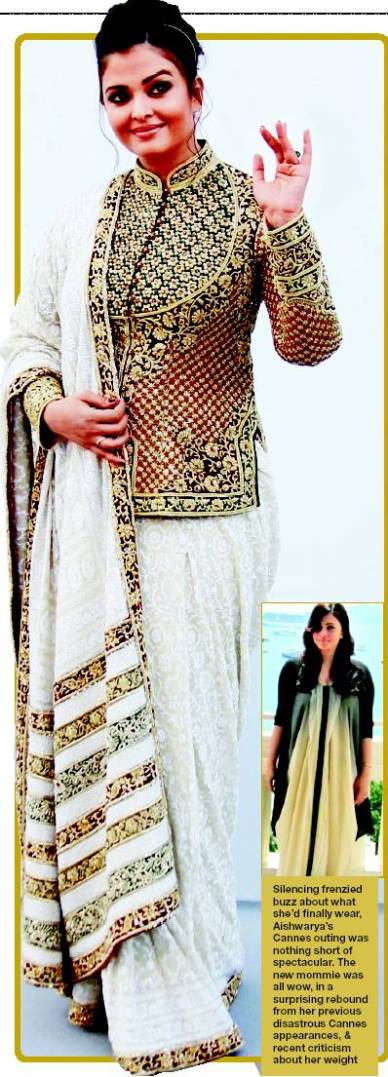
Photo Courtesy: Internet
Its a Chikan Work Saree with matching Resham and / or Zardozi Works as on the blouse with a very trendy long blouse with Resham and / or Zardozi Works (this is actually what i can see from the size of the picture i have here).
This is what designers Abu Jani and Sandeep Khosla, for whom i have a great regard.have produced for our former Miss World and daughter in law of the legendary and globally respected Amitabh Bachhan ji. Keeping in mind the quality they make or the quality that they are really capable of making, its a very ok kind of work, specially the Chikan Work.
I have full sympathy with their ok type Chikan Work, i don’t have much knowledge of Resham and Zardozi works, because at this age, Abu ji or any other person of his age who has spent so much of his time in an industry fades a little bit. I have seen that even love, which is a very positive energy, a very sacred energy has faded with the passage of time, so the love with one’s work also fades with the capability of the body as it ages.
Also because when Chikan is done with silk yarns, it comes out really beautiful, but nowadays, specially in Mumbai, folks have begun appreciating cotton (Anchor) thread Chikan Work because silk is really very delicate. Its start coming out the day you start wearing the dress.The saree above seems to be worked upon with cotton yarn.
Cotton yarn is good to work with muslins and other cottons. It gives a very good effect as can be seen below :
Abu Jani and Sandeep Khosla are most expensive in their works too. The reputation that they have earned is from their past hard works. The issue of they are making good works now or they are capable of making better works dims out here. They are the kings.
They have again inspired me to go to a more higher level of my pyramid. The thought of getting labelled as the most expensive is now transmitting new energy levels in me. Now i don’t worry of criticism, i do what i have come here to do.
I was about to buy a toy from the footpath vendor for Rs.50/-. My handphone rang. My friend Simarjeet was on the line. I told her that I’ll call her later as I was to make a payment for the toy.
She told me that there was another vendor just a block farther who was selling the same toy for Rs.47/-. She confused me for the time, but i thought it was no use walking a block to save just Rs.3/- and the Lucknowi mindset ” yeh bechne waala kya sochega” overtook the thought and I made the purchase.
Same 2nd case came just 3-4 days after that incident. I was selecting a mobile phone for Rs.22,000 something and the salesman who was also my newly made friend whispered that I can get it for Rs.20,000 to Rs.20,500 at the wholesale market barely 6-8kms away. I took the chance. Though what I lost by buying at the wholesale market is another story, we come back to our initial issue.
Comparing the 2 incidents, the price difference was around 6% but the amount involved was much greater and it is human psychology what any human being would have done.
Now we compare the same scenario in our industry. A shirt that we used to sell at Rs.350/- in 2009 is being sold at our stores now for Rs.500/-. Its inflated almost 50% in these 6 years if we take this as an example.
Another piece I take up, a dress material in cotton cloth. This piece was for Rs.2750/- in 2009 and is still at Rs.3,750/- which shows inflation of 36%.
Yet one another piece I take up, a saree in pure georgette. This piece was for Rs.8,500/- in 2009 and is at Rs.10,500/-. It means it has become dearer by 23%.
Point to be understood in all the above 3 cases is that volume sales of the shirt remained the same whereas the volume sales of the dress material and the saree dipped.
The cash inflow from sales of the saree and the dress material remained same or slightly higher though they were selling less but the inflation helped in maintaining the same sales. Here another aspect to be taken as a business that the investment in stocks increased due to this.
So why was the shirt @50%+ selling more and the dress material and saree selling less when its inflation was also less? It was because that the quality had been decreased to make it affordable enough so that it does not remain in the store shelf.
When the quality (of fabric, workmanship, etc.) goes down, it affects the overall buying process of the King (the customer).
The pure georgette fabric rose Rs.400/- to Rs.600/- per metre in these years, the workmanship rose 50% and the King says “mazaa nahi aaya” and mind it – she / he is not wrong.
With the entry of e-tailers, final price what the customer pays, has risen even more. Its deep matter that every buyer MUST understand. The portal charges the seller 10%-20% for giving him the platform, which is also their right as they have to spend heftily on advertisement and all. Their own competitive market is another story which can’t be mixed in this as it will make this longer and the subject will also drift away.
You have to keep aside another amount for models, make-up & photography. So can these sell at that (added up) high price? Answer to it is YES. People are buying. But what ends up in their hands is not the Chikan they had seen at my store. People have started selling fake Chikan on the net and new buyers understand them to be Chikan. Its a slap on our face as this is not what we were taught to sell.
Runa Banerjee ji and Sheeba ji of S.E.W.A. gave life to dying Chikan-kari in 1984. A new kind of generation, the designer generation has taken the task in their hands to keep kindled the flame. Hats off & good luck to them.
My friends ask me that i have not been active on WordPress from a long time while so many happenings have taken place in the meanwhile on which my insights were much expected.
I’ve myself been very busy to understand & work according to the laws of the government. This took a little time to respond. Sorry for that.
I know that my friends have 2 things in particular on which they want to draw my attention to. First demonetization and second GST (Goods and Services Tax) and its impact on Chikan industry.
DEMONETIZATION was a good step to tighten the noose on black money which failed due to many reasons mainly:
1. Financial & Legal Advisors.
2. Bankers
3. Security Staff
4. Commission Agents &
5. Help from friends and dependents
FINANCIAL & LEGAL ADVISORS devised ways to deposit black money in banks, insurance & other investment sectors or pay demonetized currency to suppliers & other outstanding govt. bills as electricity, water tax, house tax, etc.
BANKERS on day 1 worked in military style – NATION FIRST. Clearks worked with full devotion till 3-4 days. Then when bankers understood how they may benefit from demonetization, they started working the anti-national way which included the roles of SECURITY STAFF & COMMISSION AGENTS.
In a bizarre incident SECURITY STAFF refilling ATMs flew away with cash van. Other instances of delivering new currency at “customer’s” doorsteps in “collaboration” of COMMISSION AGENTS have also come to light.
COMMISSION AGENTS charged from 15% in the start to 40% to 60% by the final date (for depositing old notes). Some COMMISSION AGENTS were also caught by tip – off by authorities of railways, roads & by intelligence and police with huge sums of demonetized currency.
FRIENDS & DEPENDENTS deposited some money in their accounts which they paid back in later months. They also stood in queue to change the currency everyday for long hours.
Queuing for long hours to change currency of known or even unknown persons fetched these ‘line-mans’ 300 to 500 rupees a day. These were labourers who used to work as rickshaw pullers, masons & porters.
IMPACT OF DEMONETIZATION ON CHIKAN-KARI
The time was for 2017 season’s production which failed flat on the face as all the money went inside the bank not to come back soon. E-payments of any amount was permissible but the artisans had no bank accounts.
The government of Narendra Modi can’t be blamed for this as it had given ample time to the citizen to open ‘Jan-Dhan’ bank accounts which the artisans (like many other citizen) did not.
However, with the current situation the artisans stopped bringing ready goods as they knew they would be paid off in old currency which also put the brakes on acceptance of material for new production.
Point to be noted here, the artisans who had bank accounts in their villages took payment through cheques but they did not clear even in 30-40 days. Clearance (of cheques) in cities were taking more than 15 days in that time due to the rush in banks which was not giving clerks sufficient time to look in matters other than cash dealings.
So a cheque became useless a useless piece of paper for poor artisan during those days.
An instance that the Mahajans (money lenders) were taking 30%- 40% commission to pay cash right away against those cheques which was not a good bet for an artisan was also reported.
Overall, Chikan production fell to zero in those 2 months. It affected both the manufacturer & the retailer. For the manufacturer it was a GOOD period because no stock was produced, season came good, their old & stagnant stock got sold out. On the other hand it was BAD for the retailer.
Stocks were selling out due to the good season & the retailer was left with nothing else to clear the stagnant stock of the manufacturer. It was really very hard to convince the customer with the dead stock. Salesmen got a hard time & the customer was also not very satisfied.
The above statement can be understood well with sales in yearly Hyderabad exhibition where Hyderabadi people rejected them & did not give even 35% sales as in previous years. Hyderabad & Vijaywada exhibitions are places where almost all the dead stock of this season of a manufacturer gets sold out at very cheap prices (sometimes even cheaper than from Lucknow’s price).
This impression of that period on the customers’ minds is a very negative signal for the industry. Not all may understand but that will become a wound which can take a lot of time & effort to heal.
It must also be noted that Chikan roughly covers just 1% of garment industry in India so a customer has many other options whereas Chikan walahs have none.
IMPACT OF GST ON CHIKAN-KARI
Chikan & other hand-made goods like zardozi & Benarasi Saree were exempted from any kind of tax (even registration) to promote local craftsmen & trade since 1947 when India gained independence.
Traders of fabrics (uncut cloth) & Sarees were also exempt from registration & tax. Under GST these came under 5% tax. Surat in Gujrat state is the main supplier of fabrics & sarees to the entire country. It went on strike for 30-40 days. Benaras was on strike for 15-20 days. Chikan traders downed their shutters for 2-4 days. Zardozi traders took out a march in old city area against GST. But this all fetched no results.
We are talking here on Chikan trade, it got impacted. No fabric (base material) was coming from Surat in these 30-40 days. Morever, Chikan traders – in the hope that GST will not be implemented on them, did not register till 20th July. Till today just 50%-65% have registered themselves.
Due to this fabric from Surat is still not being sent to the traders here as it is mandatory to have a GST number for the goods to move from one state to the other though for the time being.
The timing of GST has affected Chikan production for Dussehra & Deepawali when it gets sold the most in Bengal, Maharashtra & some parts of southern India.
Retail buyers (customers) are getting bored by the same stuff. This scenario is going to stay for some months. Its not very easy to predict if all’s going to end well as the prices are bound to increase by almost 20% in Chikan.
Its not new that 15%-20% price hike has never touched Chikan sales. Chikan has got dearer by at least 100% in the previous 5 years by rate increase in price of cloth or workmanship, so it may be said that customers will absorb such hike for their love for Chikan-kari. But its also our duty to give them back the love they give us by offering new designs of garments & prints (blocks) and better quality & workmanship.
Once again a big THANK YOU, dil se.. to all the Chikan Lovers for standing by us in these difficult times.
A lot has already been said by people of different locations, age groups, understandings, religions & economic structure on demonetization. There was no use of me writing more on this issue.Some friends wished to know my view on this subject which made me write this.
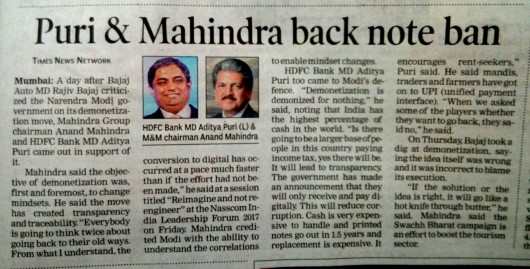 from today’s newspaper
from today’s newspaper
First of all i wish to say that i too am a normal human being like any other Indian who was a bit more or a bit less impacted by this move of our government.
Secondly, being from the Chikan-kari industry i’ll wish to stick to my arena and will provide insight related to this trade only which i think no one has till now. It took me such a long time to write here was only because i wished to get the full report before writing about this. It became like a moral responsibility for me to open all pages and analyse before posting anything here.
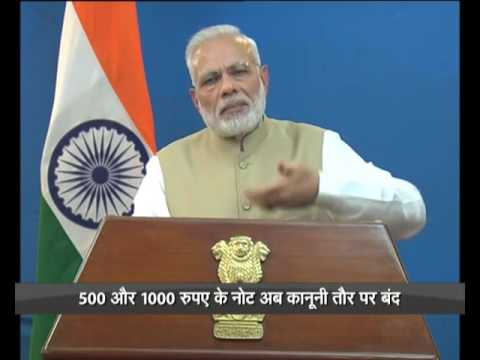
8:00p.m. 8th November, The notice reached just some people. It started spreading like wildfire till midnight. Then too, till then just 30% knew about it. Many were passing it off as a gimmick or a joke.But people became aware after reading the morning papers on 9th November. Still 10%-15% had no idea. Till writing this i understand that people in remotest part or people of non-socio circles which amount to 2500 – 3000 are still not aware of this move.
Rest about this demonitization can be read on https://en.wikipedia.org/wiki/2016_Indian_banknote_demonetisation so i wish to take you back to my subject – Chikan & Demonetization.
As you all are aware that Chikan-kari is a small scale industry which falls in the un-organised sector mainly because the people involved in this are from the ill-literate to low literacy category. The low literate category is by large (but not mainly) the trader or manufacturer who either does not know to keep the accounts or does not wish to fall in the tax net.
All from my industry, like all other citizens, were in a state of shock till 9th November as to where they will put in their accumulated (and / or unaccounted) wealth and in a state of confusion till the end of the month as many were doing brisk business by accepting old currency.
Those who had lots of cash started clearing all their dues including due (some also gave advance 2-3 months’ salaries) wages to their staff & artisans. They also cleared pending bills of their creditors / suppliers Till Date in old currency on ‘Take It or Leave It’ basis.
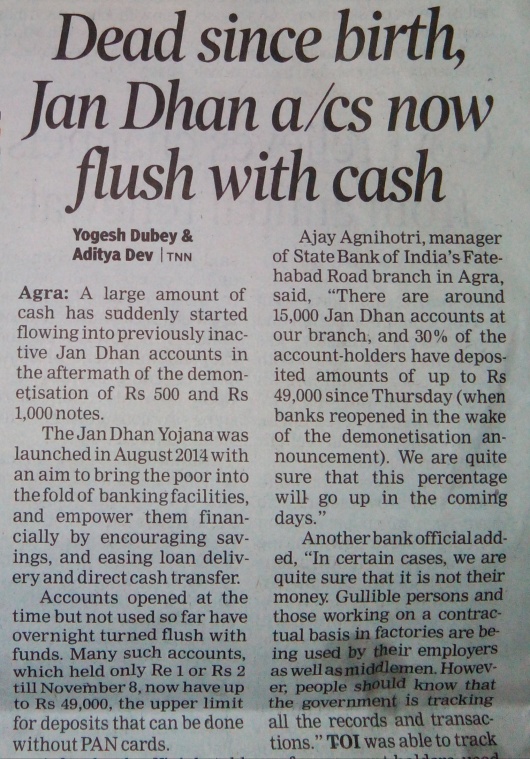
God knows how these wealthy suppliers (of thread & cloth) managed the payments received from these manufacturers but the artisan was really taken aback by this move because already note exchange was not very easy in rural area banks due to cash crunch and settling this received payment made them go in hibernate mode of wait & watch till November end.
Come December, Lucknow, like any other place, started hoarding the new currency received by fair or unfair means from the bank. Everyone had all their money back but were fascinated by the new notes so much that they did not wish to part with it by giving / spending. Also that the new denomination of Rs.2,000 was not very easy to spend at small outlets due to shortage of smaller denomination notes.
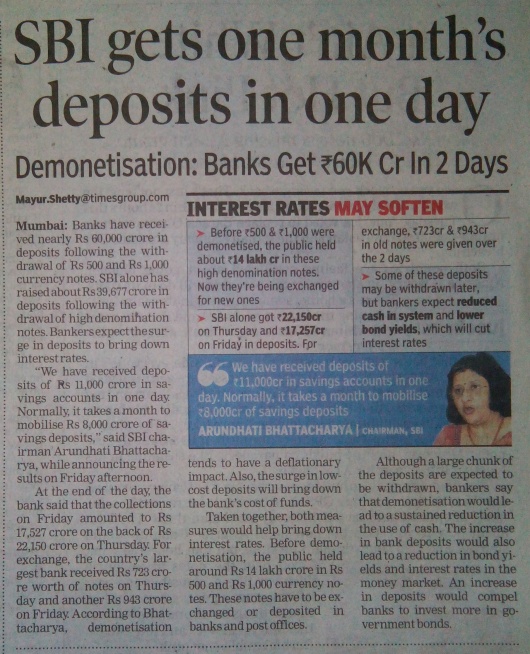 SBI Chairman had to plead people to start spending to normalize the effect
SBI Chairman had to plead people to start spending to normalize the effect
Outside orders were not coming in and Chikan had to survive on just the local retailers where almost 90% – 95% of sales were coming from digital means. Sale was good as it was the mid of the wedding season, Lucknow was abuzz with tourists attending these marriages. This sale was going directly into the retailers’ accounts. Retailers were giving payments to the wholesalers / manufacturers by cheque. So we can say that almost regular business was going on and Chikan industry had no impact of demonetization.
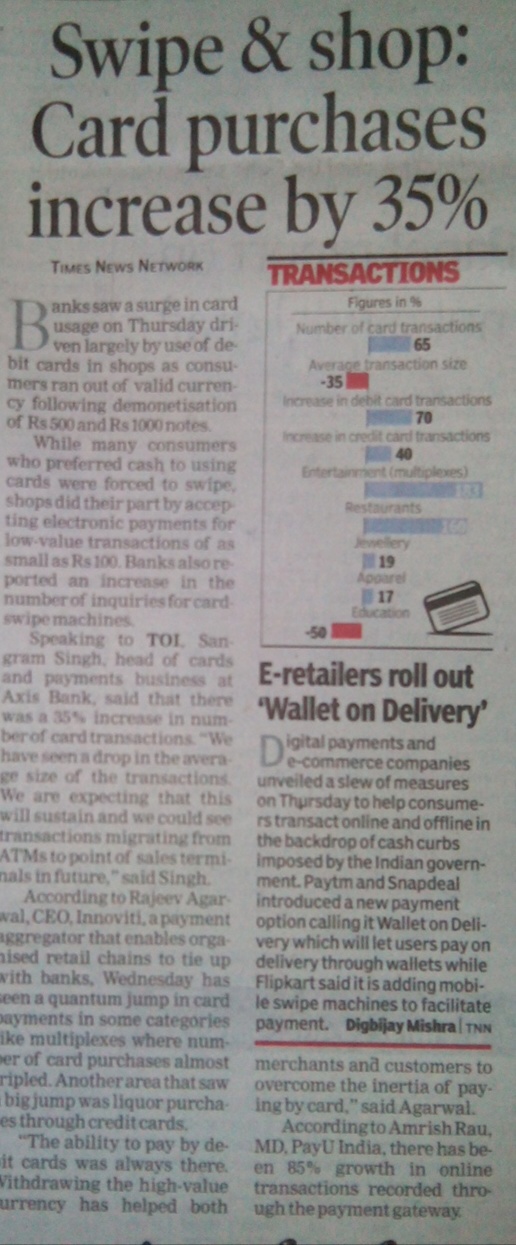
Here comes in the plight of the artisan as well as problem for Chikan-kari.
It won’t be wrong to post here that this all (demonetization) opened up the records of the artisan, or better corrected, the middle men, who were understood to be a downtrodden part in Chikan-kari trade were making a lot of money without any bank accounts, without any tax and its not just being said here without relevance and proof.
A decent manufacturer pays out almost 1-2 lakhs per middlemen per week (or max per fortnight) and there are at least 5-8 middlemen who work for this manufacturer. So this manufacturer needs around 5-8 lakhs as a minimum each month to keep the business running. But the government gave a limit of 24,000 per month to be withdrawn from an account in cash. There was no limit for cheque / digital payment. So the option of giving the artisan by cheque was the only option with manufacturers.
Here its interesting that first the artisan had not opened a bank account due to religious belief and unknowingness of operating of an account and second that even if he has an account, he deposits it in his account, it clears in 20-25 days because all banking staff in Lucknow is busy with the rush in the bank leaving no time to attend clearings. And even though this was not enough, he’ll have to pay for his needs in his village by digital / banking transaction. This makes it not wrong to say that Chikan production stopped for almost these 2 months.
The problem with the Indian population is that we want everything for free. Its just the 1.25 crore people in India above the income limit who pay tax out of which many are in the salaried section where it becomes a compulsion to pay tax. Is it not a cruel joke?
Now the real test for the artisan will be to keep accounts, though this won’t be easy but he’ll be bound to pay tax and contribute to nation’s progress which he was evading till now.This lash on the middlemen / artisan is being welcomed by manufacturers. It was because of this missing link that many nation loving, tax paying manufacturers were manipulating with their account books and therefore stacking unaccounted wealth & not contributing to nation building by evading proper / full tax.
Whatever was the outcome, the end has become to be very happy. Artisans have opened their accounts now and they have started understanding how to transact digitally.

A question posted by a friend of KRISHNA – What do you do with pieces that get defective during the process of making Chikan-kari?
Let’s first understand the defects. The main defects that arise in almost all fabric garment industry are: 1.damage in cloth (torn, hole) 2.discolouration in final wash 3.weaving defect & 4.puled yarn (especialy in hand embroidered goods)
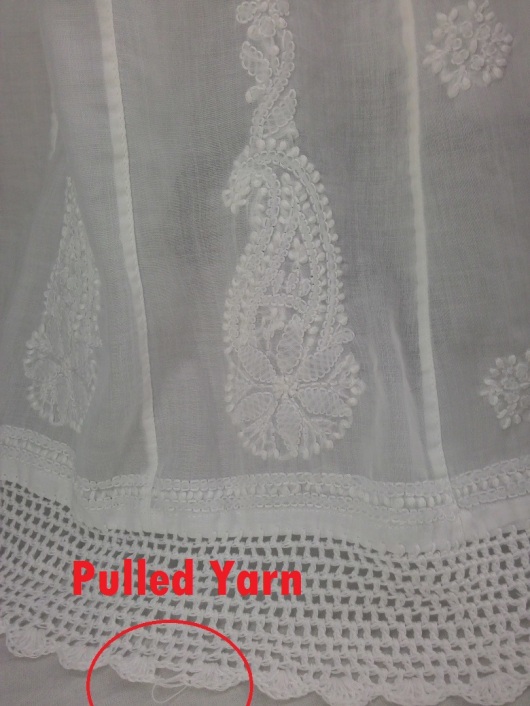
Jpeg
Chikan-kari is a process which passes through the human eye at every junction. The fabric is physically checked before sending it to cutting for weaving defects and damage. Then it goes to printing, then embroidery and finaly washing. In cases other than dress materials & sarees, stitching is also involved. Only washing is a process that is not responsible for any checks as the final piece is checked at the place where this journey started ie. the shop or workshop, otherwise the piece is stopped by any wise worker for further processes.
At the workshop, these final pieces come with the extra (left over / unused) thread that had been given at the time of sending the pieces for embroidery which serve a very important purpose. If wise people are involved, very little chances are that pieces will get torn. If a piece get torned a bit, it is darned and a booti (motif) is made with the extra thread i mentioned above. If the booti is looking out of place in a design, more bootis are added to the design to camouflage the original.
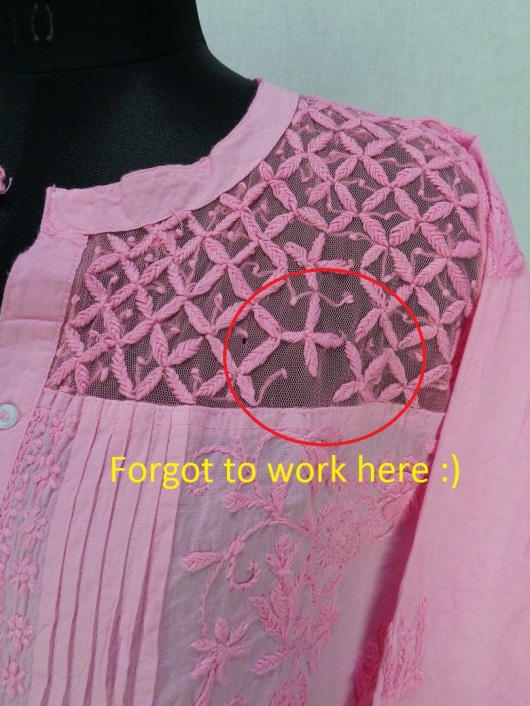
If discolouration occurs in washing which is 0.001% chance, such pieces are kept aside.
Weaving defects run throughout a piece if left unchecked in initial stage. If these are covered by the embroidery, there is no chance than to sell them off at any price at the soonest. But if a weaving defect is in an open space, these are also hidden by making embroidery in mirror pattern. Bail (long designs of creepers, etc.) blocks are printed on the defect & its mirror space and embroidered. So much extra thread is not availabe every time with a final piece, so matching thread is bought and the piece is embroidered again at the workshop or shop. After final wash if the two threads (old & new) don’t match, the piece is kept aside.
Hand (or even hand machine) embroidery is made by pulling the fabric in a loop frame. Then it is embroiderd. Sometimes the yarn gets pulled to one side especially in delicate cloths like muslin, georgettes, etc.
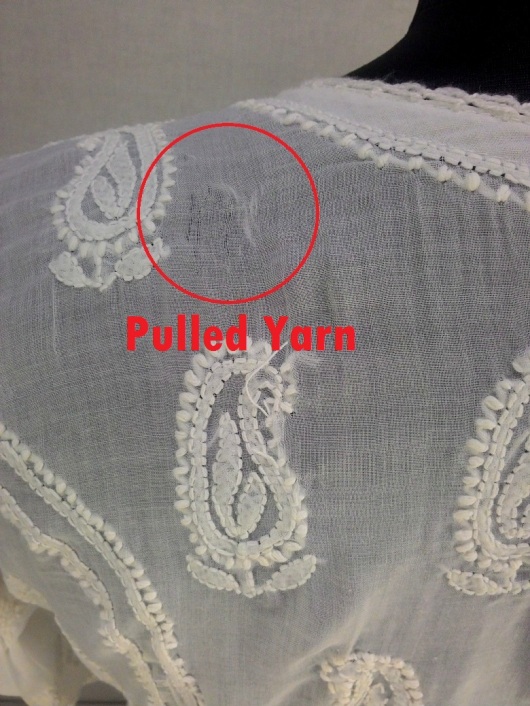
Jpeg
It is a common feature and does not harm the strength of the fabric. The pulled yarns go back to their initial place after 2-3 washes. This feature is un-avoidable / inevitable in making embroidery. Old buyers know it and don’t hesitate in buying such pieces but its a defect to a new customer. If the seller is able to convince these new customers, good, otherwise he / she knows that it will sell off eventually.
Now about the pieces that we had kept aside. The discoloured / mis-matched pieces are sent for dyeing. Different dyeing techniques like batik, tie-die, stone wash, spray dyeing have added to the beauty as well as saved the manufacturers from possible loss
Firstly, i wish to convey that KRISHNA is neither affiliated to or inclined to any political party nor does it have a say in political affair.
It was hardly 5 months the Narendra Modi government had formed. Weavers from Benaras (Varanasi) had come to Lucknow for some religious meet. They came to my shop too for buying some Chikan-kari stuff.
According to their status they purchased decently from us. But one thing was in common in them, they were were very upset with Narendra Modi in particular. They said Benarasi Handloom was at its lowest in his phase.
I was a seller, a seller has to just sell, its his / her first duty, his / her first devoir. Though i very well know as a businessman that nothing comes or goes in a second in business, it takes time either to rise or to fall, and a already risen business – Banarasi, was at sky level. Every family who wished to marry off their daughter took pride in sending her to her new home in a Benarasi saree, the business was so strong.
Benarasi also got G.I. certification from the government much before Chikan-kari, which meant that they were made secure and had no competition from outside forces, they had to compete with themselves only.
Now coming back to the reason for me to write this days’ blog.
I have continuously being reading that Benaras has attracted again many tourists & designers for Benarasi weave and silk. Here are some excerpts :
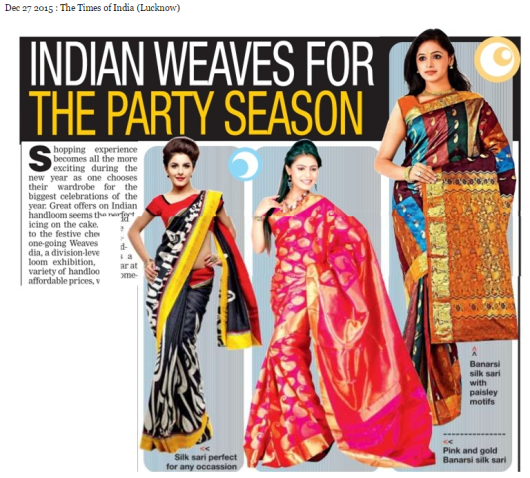
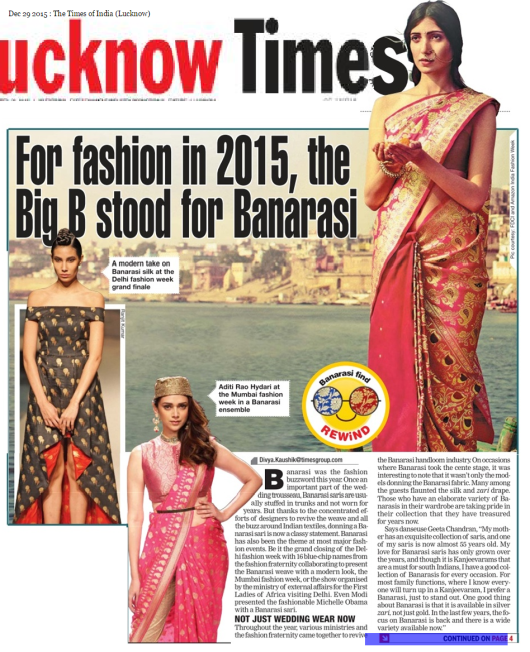
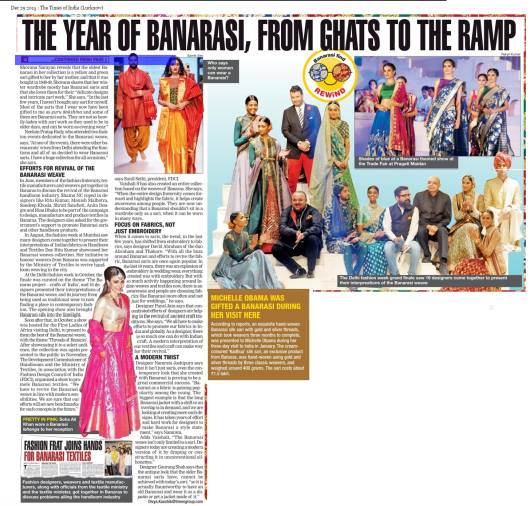
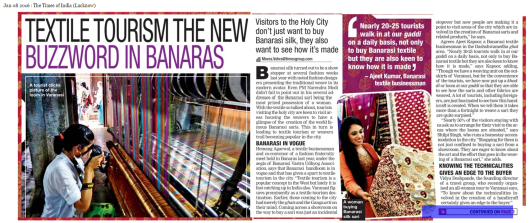
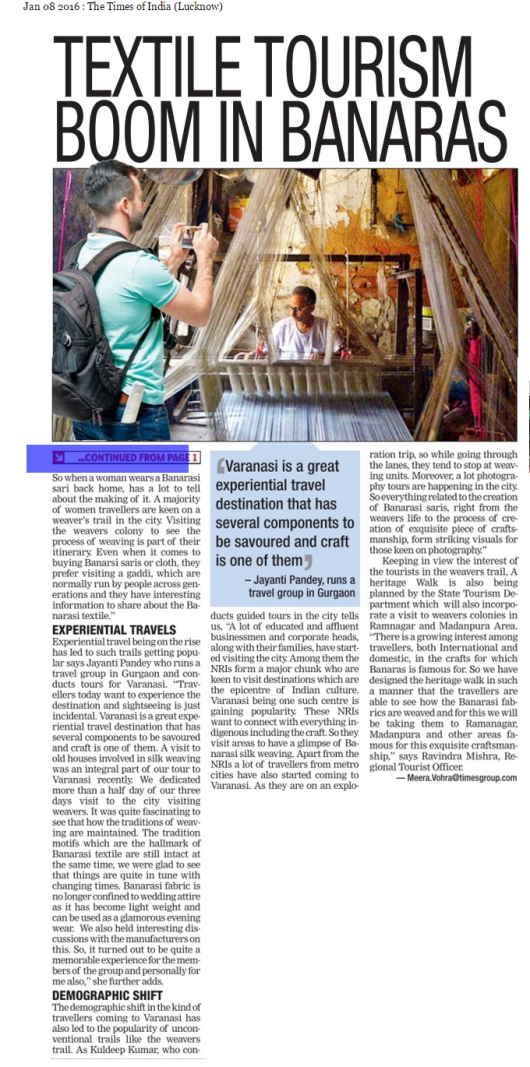
This makes me say that people who fight the odds that their markets are facing are the people who soar.
Picture Courtsey : Times of India
P.S. If the text is not very clear in some images, kindly click on the pics, they will open in new winow
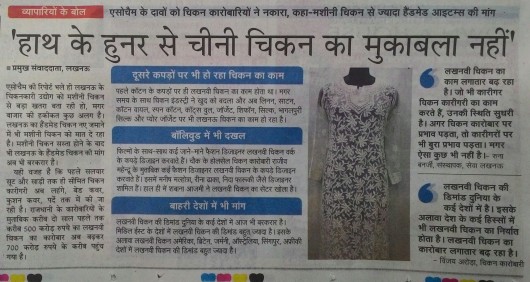
Jpeg
Whenever a guest visits you (a Lucknowite) in the winters, its sure you’ll ask him for (to eat) Lucknow’s speciality Malai-Makhan.
The word in itself is so heavy that all health & weight conscious guests will certainly so NO.
Malai-Makhan is a light and sweet food item that is found only in the winters’ mornings. It disappears as soon as it lands in your mouth. The newer version of richness is a little heavier which leaves behind a sticky taste in your palate and tounge.
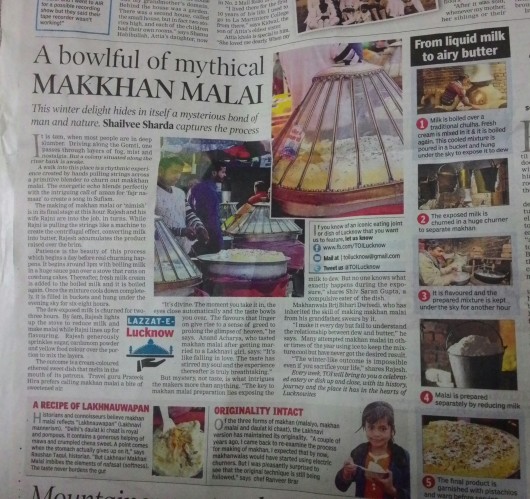
Jpeg
|
Nov
30 2015 : The Times of India (Lucknow)
Muslim women take to Islamic fashion fusion
Indian Muslim women are increasingly looking for Islamic fashion, that not only gives them traditional kurtas and abayas but also wide-legged jeans, long skirts, and classic western tops. For those who thought it will be tough to get Islamic clothing fused with western style, there are now options such as the `Khalida dress’, marked by contrasting color and understated modesty; also a wrinkle-resistant line known for elasticized sleeves and a front opening or the smart-looking `military jilbab’ and the sporty `drawstring dress“. These vibrantly-coloured dresses are a far cry from the black Saudi-made abayas found in India.Women here love this idea because it breaks stereo types about Muslim women.“There is a desire in Muslim women to make the abaya and hijab reflect their confidence and not suppression.One way of doing this is by sporting urban and funky Is lamic or Muslim fashion,“ said Maryam Khan, a Lucknow-based doctor who loves her maxi skirt with a head scarf and wonders at how the western-inspired Muslim fashion weds fun with faith. The players here are second generation Muslims who grew up in the west.They are opening fashion houses for the modern yet modest Muslim woman.
There is the Islamic Design House that boasts a sporty and urban take on modest clothing, Shukr that focuses on fusing tradition with modernity and Arab, which is unique in providing a minimal feminine take on modest clothing. These London-based fashion houses have now set up online outlets in India because of demand by India customers on Facebook. The fashion houses were started by women educated at the London School of Economics and other prestigious institutions and who have lived in New York or are familiar with avant-garde Euro pean fashion. The head designer of Shukr, Tabassum Siddiqui, graduated from the prestigious Parsons School of Design in New York City and has worked under some of he most coveted names in he fashion world such as the Spanish designer Miguel Adrover and New York-based ashion photographer Roderick Angle. These fashion houses reveal that the highest demand or Muslim fashion comes rom the Middle East (Egypt, Jordan, Palestine), the Maghreb (North Africa) and he West. Since Indian Mus ims are also inspired by wes ern-style Muslim fashion, designers have included India in their international si e, which is, as they say, also he fastest growing sector for his kind of fashion. Please refer to my old blog https://krishnachikan.wordpress.com/2012/09/ which has this fashion’s start in 2009.
Very late written article from TOI
|